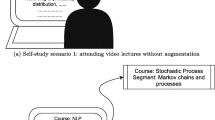Abstract
The rise of massive open online courses had as a result an increase in the number of open online educational video lectures on the web, as well as in the number of users who watch them. The present work aims to optimize the searching time within an educational video lecture based on the users’ opinion. The research presents a novel procedure for the automatic point of interest detection in an educational video lecture. State of the art algorithms are used to extract terminology from the users’ comments and video lectures topics from relevant video transcripts. The topics of each video lecture are assessed based on the terminology resulting from the users’ relevant comments. The topic with the best score (adding the keyness value of common topic-related words and terminology words) is selected as the most relevant to the video lecture. Then videos’ timestamps that include the selected topic’s words are presented to users as the points of interest of the video lecture. Finally, a user evaluation experiment is carried out, the results of which strengthen the reliability of the proposed procedure.



Similar content being viewed by others
References
Alharbi G, Hain T (2015) Using topic segmentation models for the automatic organisation of moocs resources. In: EDM, pp 524–527
Anthony L (2014) Antconc (version 3.4.3)
Biswas A, Gandhi A, Deshmukh O (2015) Mmtoc: A multimodal method for table of content creation in educational videos. In: Proceedings of the 23rd ACM international conference on multimedia, pp 621–630. ACM
Blei DM, Ng AY, Jordan MI (2003) Latent dirichlet allocation. J Mach Learn Res 3:993–1022
Cha M, Kwak H, Rodriguez P, Ahn YY, Moon S (2007) I tube, you tube, everybody tubes: analyzing the world’s largest user generated content video system. In: Proceedings of the 7th ACM SIGCOMM conference on Internet measurement, pp 1–14. ACM
Chorianopoulos K (2013) Collective intelligence within web video. Human-Centric Comput Inf Sci 3(1):10
Deldjoo Y, Elahi M, Cremonesi P, Garzotto F, Piazzolla P, Quadrana M (2016) Content-based video recommendation system based on stylistic visual features. J Data Semant 5(2):99–113
Gabrielatos C, Marchi A (2012) Keyness: Appropriate metrics and practical issues. In: CADS International Conference. Available at http://repository.edgehill.ac.uk/4196/1/Gabrielatos (accessed 10 November 2017)
Gelbukh A, Sidorov G, Lavin-Villa E, Chanona-Hernandez L (2010) Automatic term extraction using log-likelihood based comparison with general reference corpus. In: International conference on application of natural language to information systems, pp 248–255. Springer
Giannakopoulos T, Makris A, Kosmopoulos D, Perantonis S, Theodoridis S (2010) Audio-visual fusion for detecting violent scenes in videos. In: Hellenic conference on artificial intelligence, pp 91–100. Springer
Hofmann M, Klinkenberg R (2013) RapidMiner: Data mining use cases and business analytics applications. CRC Press
Hoic-Bozic N, Dlab MH, Mornar V (2016) Recommender system and web 2.0 tools to enhance a blended learning model. IEEE Trans Educ 59(1):39–44
Imran H, Belghis-Zadeh M, Chang TW, Graf S, et al. (2016) Plors: a personalized learning object recommender system. Vietnam J Comput Sci 3(1):3–13
Ji X, Liu H (2010) Advances in view-invariant human motion analysis: a review. IEEE Trans Syst Man Cybern Part C Appl Rev 40(1):13–24
Liu B, Liu L, Tsykin A, Goodall GJ, Green JE, Zhu M, Kim CH, Li J (2010) Identifying functional mirna–mrna regulatory modules with correspondence latent dirichlet allocation. Bioinformatics 26(24):3105–3111
Mansoorizadeh M, Charkari NM (2010) Multimodal information fusion application to human emotion recognition from face and speech. Multimed Tools Appl 49(2):277–297
McCallum AK (2002) Mallet: A machine learning for language toolkit
Park D, Ramanan D, Fowlkes C (2010) Multiresolution models for object detection. In: European conference on computer vision, pp 241–254. Springer
Pazienza MT, Pennacchiotti M, Zanzotto FM (2005) Terminology extraction: an analysis of linguistic and statistical approaches. In: Knowledge mining, pp 255–279. Springer
Philbin J, Sivic J, Zisserman A (2011) Geometric latent dirichlet allocation on a matching graph for large-scale image datasets. Int J Comput Vis 95(2):138–153
Pojanapunya P, Todd RW (2016) Log-likelihood and odds ratio: Keyness statistics for different purposes of keyword analysis. Corpus Linguistics and Linguistic Theory
Rayson P, Garside R (2000) Comparing corpora using frequency profiling. In: Proceedings of the workshop on Comparing Corpora, pp 1–6. Association for Computational Linguistics
Rosen-Zvi M, Griffiths T, Steyvers M, Smyth P (2004) The author-topic model for authors and documents. In: Proceedings of the 20th conference on Uncertainty in artificial intelligence, pp 487–494. AUAI Press
Rousseau A, Deléglise P, Esteve Y (2012) Ted-lium: an automatic speech recognition dedicated corpus. In: LREC, pp 125–129
Wei X, Croft WB (2006) Lda-based document models for ad-hoc retrieval. In: Proceedings of the 29th annual international ACM SIGIR conference on Research and development in information retrieval, pp 178–185. ACM
Willett P (2006) The porter stemming algorithm: then and now. Program 40 (3):219–223
Zhang H, Sun M, Wang X, Song Z, Tang J, Sun J (2017) Smart jump: Automated navigation suggestion for videos in moocs. In: Proceedings of the 26th international conference on world wide web companion, pp 331–339. International world wide web conferences steering committee
Zhou X, Chen L, Zhang Y, Qin D, Cao L, Huang G, Wang C (2017) Enhancing online video recommendation using social user interactions. The VLDB Journal, pp 1–20
Author information
Authors and Affiliations
Corresponding author
Additional information
Publisher’s Note
Springer Nature remains neutral with regard to jurisdictional claims in published maps and institutional affiliations.
Rights and permissions
About this article
Cite this article
Kravvaris, D., Kermanidis, K.L. Automatic point of interest detection for open online educational video lectures. Multimed Tools Appl 78, 2465–2479 (2019). https://doi.org/10.1007/s11042-018-6372-z
Received:
Revised:
Accepted:
Published:
Issue Date:
DOI: https://doi.org/10.1007/s11042-018-6372-z




